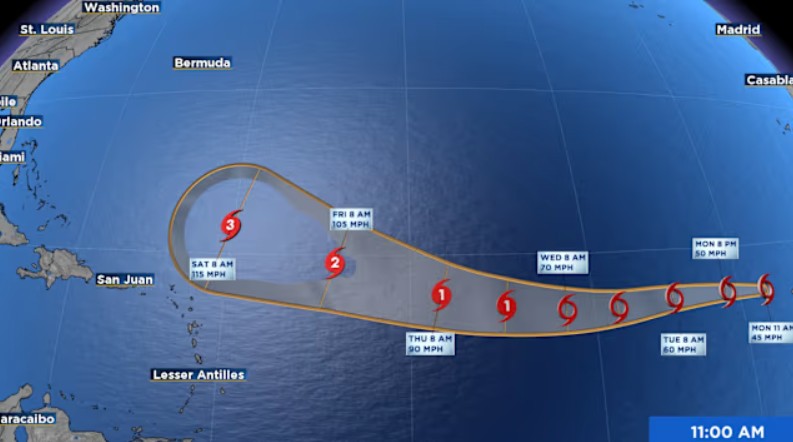Atlantic Hurricane Season – Forecasts, Tracker & Erin Storm Updates
The Atlantic hurricane season runs from June 1 to November 30, a period when tropical cyclones are most likely to form over the Atlantic Ocean, the Caribbean, and the Gulf of Mexico. This article compiles seasonal forecasts and storm updates to help coastal residents and authorities make timely decisions.
Notable Storms in the 2025 Atlantic Season
In the 2025 Atlantic hurricane season, Hurricane Erin stands out as the most notable storm.
Originating from a low-pressure area off the coast of Africa, Erin rapidly intensified as it moved across the warm waters of the Atlantic. Within just a few days, wind gusts exceeded 100 mph, elevating Erin to a major hurricane.
Forecast models projected Erin’s path toward the northwest, threatening Caribbean islands before approaching the U.S. East Coast.

In addition to powerful winds, the storm carried heavy rainfall, posing a high risk of widespread flooding and large coastal waves
Several coastal states issued emergency alerts, advising residents to stock up on essentials, fortify their homes, and be ready to evacuate if necessary.
Alongside Erin, this year’s season has also seen several other Atlantic tropical storms. While they did not reach major hurricane status, these systems still brought heavy rain, localized flooding, and transportation disruptions.
About Atlantic Hurricane Season
The Atlantic Hurricane season is the period of the year when tropical cyclones, including tropical depressions, tropical storms, and major hurricanes are most likely to form in the Atlantic Ocean, the Caribbean Sea, and the Gulf of Mexico.
The official season runs from June 1 to November 30, with peak activity typically occurring in August and September, when warm sea surface temperatures and favorable atmospheric conditions foster hurricane development.
In the context of climate change, the Atlantic hurricane season 2025 is drawing particular attention due to the potential for above-average activity.
When compared with recent years, the 2020 hurricane season recorded 30 named storms, the highest in history, while 2023 was closer to average with 20 named storms.
The 2025 forecast indicates an upward trend in activity, though not at record levels. However, it still poses significant risks to coastal areas from the Caribbean to the U.S. East Coast.

Safety Tips & Preparedness During Hurricane Season
Rough seas and rapidly developing Atlantic storms can leave coastal residents unprepared, leading to severe loss of life and property damage.
By having a preparedness plan in place, you can protect yourself and your family, minimize property damage, and ensure safety.
Essential supplies for you and your family to prepare for hurricanes
- Bottled drinking water (enough for at least 72 hours)
- Canned food or non-perishable dry food that doesn’t require refrigeration
- Flashlights with batteries, extra batteries, or portable chargers
- A basic first aid kit and essential medications
- A portable radio (battery-powered or solar-powered)
- A paper map of your local area and emergency contact information
- Sleeping bags, blankets, and spare dry clothing
Evacuation plan in case of an emergency order
- Identify known evacuation routes and the nearest safe shelter.
- Inform your family of the meeting location and communication plan in case you get separated.
- Prepare a small “go-bag” with essential items (personal documents, cash, keys, medications, etc.) for quick evacuation.
- Always monitor local updates: if there’s a mandatory evacuation order, follow it immediately, even if you feel safe, to avoid unnecessary risk.
A well-structured preparedness plan enables you to respond effectively when a hurricane strikes, preventing the situation from becoming dangerously out of control.
For accurate and timely alerts, prioritize official updates from the NOAA Hurricane Center and local media channels.
Check reliable information sources at least every morning and evening, especially when a storm is forecasted to approach.
Difference between a Hurricane and a Tropical Storm
Many people confuse a hurricane with a tropical storm. The main difference lies in wind speed and pressure:
- Tropical Storms Atlantic: Wind speeds of 39–73 mph (63–118 km/h). While less intense, they can still produce heavy rain and widespread flooding.
- Hurricane: Wind speeds of 74 mph (119 km/h) or higher, with lower pressure and greater destructive potential. According to the Saffir–Simpson scale, hurricanes are categorized from Category 1 (minimal damage) to Category 5 (catastrophic).
Understanding the difference between a hurricane tropical storm will help you assess risk levels and prepare an appropriate response during the Atlantic hurricane season.
>>> Read more: Which Providers Offer Free Government Phone in Florida
